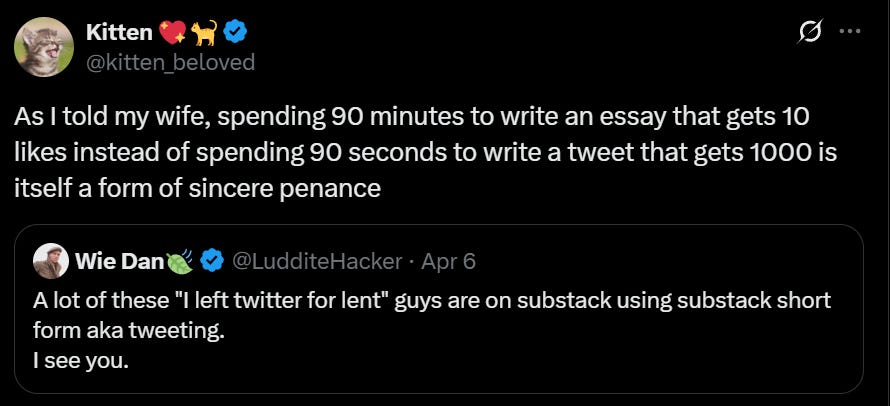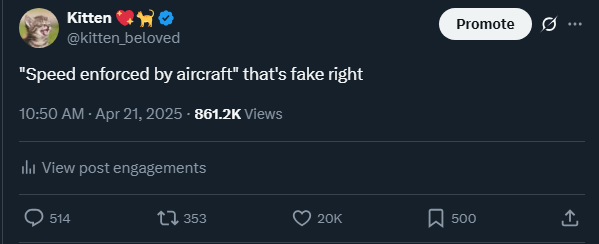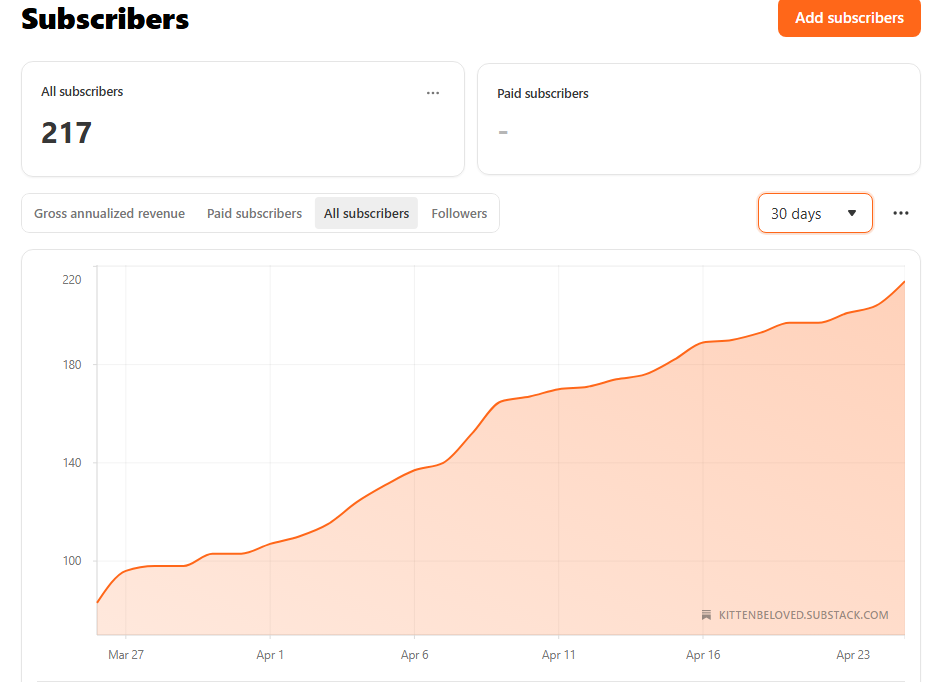Posting, fast and slow
Reflections on 40 days of substack from a twitter microcelebrity
For the second year in a row, I gave up twitter for Lent. No posting or scrolling for 40 days (plus Sundays, I did not put down my penance on feast days). But Lent is not solely about penance and deprivation. We’re also encouraged to take up positive habits, perform acts of kindness and charity, etc. I decided breaking my scrolling habit would be an excellent opportunity to get back into longer-form writing and launched a substack, and I’m vain enough that I consider this a gift to the world as well as to myself.
On the whole I have really enjoyed the experience so far and plan to stick around. I’ve been on here for a bit over 50 days, and published 9 essays in that time. This comes out to a little less than two a week, a pace I think I can sustain in the long term. It’s already evident that I’ll be able to find my audience and grow a readership without too much overt self-promotion.
As someone well established on and hopelessly addicted to twitter, substack is at once pretty familiar and surprisingly different. Here are my initial impressions.
It’s a slow burn
The starkest difference from twitter is the pace of life. A tweet lives and dies in 24 hours, like a fruit fly. You know within the first 30 minutes whether it has any legs or is permanently dead in the water. If a tweet is still getting interactions a couple days after you posted it, it’s probably because you’re having the worst week of your life and are too proud to delete the stupid bait you posted. There’s no such thing as a “greatest hits” or “back catalog” in the world of tweets — you get those eyeballs immediately and then never again, no matter how great a tweet is. If one somehow returns from the dead months or years after posting, it again probably means you’re questioning your life choices.
Meanwhile, substack’s natural lifecycle is the week, and months or years are meaningful units of time as well. The news of the day has a special place like anywhere else, but the period of discussion for any piece of writing tends to be several weeks, and it’s not at all unusual for popular pieces to receive a steady stream of eyeballs months or years after their publication. Part of this is of course algorithmic — substack intentionally places hit essays “from the archives” in front of readers. But a bigger piece seems to be the nature of the medium itself. Longer essays can be worth reading and reconsidering long after they are written in a way that ephemeral 280-character tweets never can be.
The reward to effort ratio is completely backwards
Some twitter bros poked fun at me when I peeked my head back up after Mass on Holy Thursday, and while they surely have a point that stacking is methadone for tweeting, it’s just not the same.
Yes, part of this is that I have 20k followers on twitter and only a couple hundred here. But even controlling for that obvious factor, there’s really no comparison between the two platforms in terms of the dopamine delivery relative to the effort it takes. The tweet above is actually exaggerated in both directions: 90 minutes is fast for an essay and 90 seconds is slow for a tweet. This one took me no more than 20 seconds and it got me 20k likes.
Meanwhile I spent well over 2 hours on at least a couple of my 9 substack essays and my most popular one has barely cleared 100 likes (although it’s still accumulating them weeks later, unlike banger tweets). In general the only way to write, either short or long form, is to do it for yourself and hope an audience finds you. I both tweet that way and write essays that way, and my audience indeed finds me. But it would be churlish and dishonest to claim I don’t get high all day on a steady drip of twitter engagement on top of any self-satisfaction in a way that just isn’t true for substack. Maybe there will come a day when I can regularly get thousands of likes here, but a) that’s not in sight from my current numbers, and b) there’s still that little factor of at least 500 in terms of the effort involved. It’s just not the same thing and never will be.
The field is thin and nobody is here
My first week or so on substack as a reader was genuinely impressive and felt like an intellectual renaissance. I was discovering essay after essay packed with trenchant insights and florid prose. I thought I had discovered an endless mind palace of delights, a bottomless well of quality writers and content.
But after that first honeymoon week, when substack had run out of greatest hits to show me, the quality and profundity of the essays being recommended for me to read next declined precipitously, as did their quantity. The well was not so deep as it first appeared. Pretty soon I was being recommended tawdry orgy memoirs and rants using admittedly pretty creative euphemisms for black people, both liberally peppered with truly terrible AI slop clipart. This platform is great, but where is everybody?
Prolific tweeters are a dime a dozen, again presumably owing to the difference in effort, both for readers and writers. Not to toot my own horn, but my own mutuals on twitter include dozens of tweeters with followings in the tens of thousands, and that’s just the anons. If you pull in face accounts then double that number.
Meanwhile it seems very rare on substack for anyone without a substantial real-world following to have amassed even a few hundred subscribers, free or otherwise. I don’t think this is because it’s especially challenging to grow a readership here assuming some level of talent and work ethic, I think its because so few people are trying. I don’t claim to be a brilliant generational essayist, and here’s my growth from writing just nine essays:
Follow the trendline and it’s easy to see I’ll have a thousand or so subscribers by years’s end. The slow-burn cycle and re-cycle of substack means that articles continue to pay dividends long after you write them. I’m writing about two a week, so a hundred a year, which means that presumably this growth will accelerate over time as well.
Maybe I’m wrong and there are in fact thousands of talented anons writing here regularly, but if so I sure haven’t found them. Mostly it’s alternative old-media (the Bari Weiss cluster), sexcapade stories by current and reformed sluts, and hundreds of C-tier working comedians complaining about how hard it is to build a following. (“Building a following” is fake and gay: it’s a side effect of writing things people want to read, not an activity in itself). Again — where are the great anons who write more than a couple times yearly? Have I just not been here long enough to find them? Time will tell I suppose. Twitter had introduced me to dozens of anons I still read regularly in my first month of membership, and the same just hasn’t been true here.
On the readership side of the equation, things are similarly thin. It’s generally agreed that getting a thousand likes on a substack essay is a certifiable monster hit, and I’ve only seen a handful of such essays. Are substack readers content to just lurk for the most part? Or is nobody here, as seems to be the case?
The twitter-substack hyperwar is gay and must end
When you’re writing a substack article, every kind of hyperlink you paste into the editor turns into an appropriate embedded multimedia preview. This is true of youtube videos, tiktoks, sound clouds, facebook links, and of course other substack essays. It works for basically everything with the appropriate media markup tags. The only thing is doesn’t work for is twitter. Those remain bare text, not even hyperlinks. If you want to embed a tweet, you have to do it yourself, manually, with a screenshot and link.
Meanwhile on twitter, all links are deboosted, but substack links are super-deboosted. For a while even saying the word substack on twitter allegedly had roughly the same effect on algorithmic placement as arguing a little too stridently about the age of consent. There are supposed workarounds, like only mentioning the substack link in the second tweet in a thread, but why should they be necessary?
Twitter and substack should be best friends: substack for writing long-form content, for reading your subscribed authors’ latest work, and to host the official timeless discussion thread for each article; and twitter for sharing and shitposting and arguing about the essays you find on substack. The two platforms are good at different things, as should hopefully be obvious by now. Elon’s move to cut off a potential destination for left-white flight and kneecap a new competitor feels petty, unnecessary, and baby-dicked. Meanwhile substack’s retaliatory half-measures feel even more pointless, considering how much they need the global forum taking place on twitter. At this point I don’t care who started which beef or when, I just know that both companies need to stop the gay little slapfight and make up, for their own sakes and for ours.
Parting thoughts
This is already longer than I intended, which is another unsurprising feature of the medium. I’ll close by mentioning that the current meta-discourse on substack revolves around how the introduction of video content will doom the platform. Please take a deep breath. If you’re a long-form writer, people who want to watch video aren’t your readers. If you’re a long-form reader, then don’t follow people who post video, or scroll past it. This is a fake problem invented by people who don’t have real ones.
Until next time, I remain your faithful correspondent.




FWIW: we don't prohibit Twitter links from being embeds; that's Twitter doing that, refusing to serve Tweet data to our servers / calls. I don't think we have done anything contra Twitter or to harm Twitter or Tweets that I'm aware of, and wouldn't; it wouldn't help us, we have no leverage against them, and we're not "mad" at them in any meaningful sense, and we don't make decisions based on that sort of thing anyway. We obviously wish they weren't crushing Substack links, but all the ad platforms are starting to murder off-platform links, so it's not even that distinct from how others operate now.
Note for example that all our share flows offer Twitter ("X") as an option, you can put it in your bio links, etc. The code on our side pulls whatever embed it can from any link; Twitter blocks us from doing so with Tweets, that's all!
Really great overview post, BTW.
The reason for the fast growth is because of a lack of supply, as you say. Blogging with consistency is just really hard for some reason. I'm a complete unknown, with no prior internet presence and I've experienced a similar growth trajectory as you - and you're already known.
No one is trying.